Cara Membuat Pemodelan UML menjadi Agile & Tepat Waktu
Artikel ini akan menunjukkan kepada Anda bagaimana menerapkan dengan efektif pemodelan UML baik dalam cara agile maupun tepat waktu dengan fitur Model ETL yang kuat.
Sebuah model UML atau diagram adalah pandangan spesifik tentang apa yang Anda coba pahami dalam konteks tertentu.
Seringkali, kita ingin mengumpulkan / mengekstrak data dalam diagram untuk melakukan analisis lebih lanjut & prioritas, menambahkan komentar dan anotasi, melampirkan biaya atau informasi relevan untuk daftar elemen dan lain-lain dalam bentuk tabel. Namun, data ini biasanya tersebar di seluruh diagram (di sini dan di sana) terkubur dalam bentuk, popup atau jendela properti, yang tidak memungkinkan bagi kita untuk menanyakannya dalam tabel. Atau sebagian besar waktu kita bahkan perlu menyalin dan mengatur ulang mereka secara manual ke dalam format yang diinginkan untuk analisis lebih lanjut.
Tabel Model ETL (extract-transform-load) diciptakan untuk memenuhi tujuan ini. Sekarang, Anda dapat dengan fleksibel menggunakan kemampuan kueri ETL untuk mengekstrak data yang diinginkan untuk digunakan dalam mengembangkan model Anda dengan cara tepat waktu dan agile untuk berbagai aspek.
Jadilah bos sejati dari proses pengembangan perangkat lunak Anda dengan teknik pemodelan UML dengan cara yang sangat agile!
Ambil Tur Cepat — Pemodelan UML Agile dengan Model ETL oleh Visual Paradigm
Model ETL Sesuai Permintaan
Ekstrak, Transformasi, dan Muat model dengan alat pergudangan model yang kuat.

Ekstrak: Dapatkan Pandangan Menyeluruh tentang Artefak Pemodelan
Mesin ETL membaca dan menganalisis jenis artefak pemodelan tertentu dan mengekstrak informasi yang diinginkan ke dalam tabel model-ke-properti; memberikan pandangan ringkas tentang elemen model yang sebaliknya bisa tersebar di seluruh diagram dan jendela properti.
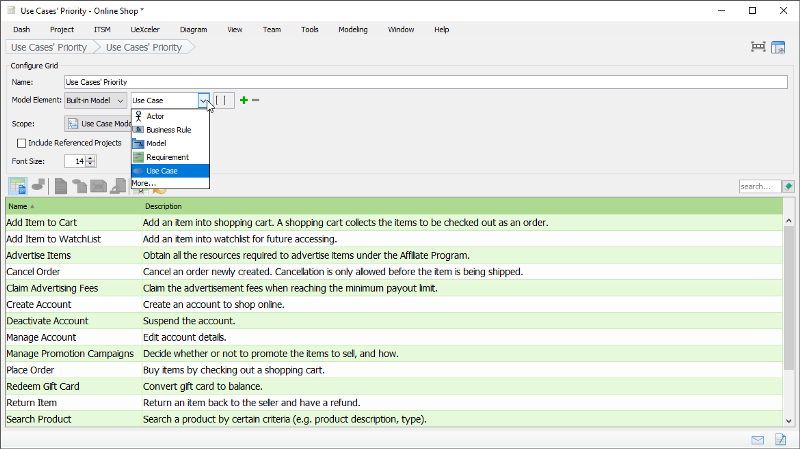
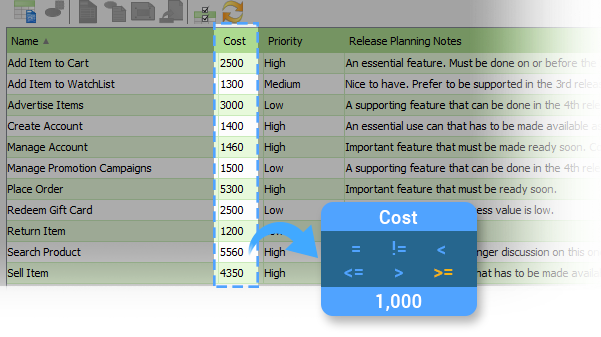
Saring Konten Tabel berdasarkan Kondisi
Konfigurasikan tabel ETL dengan fleksibel agar sesuai dengan kasus penggunaan tertentu. Dengan menerapkan kondisi yang berbeda, Anda dapat mencantumkan elemen yang Anda minati. Untuk mencantumkan kasus penggunaan dengan biaya lebih dari 1.000? Atau untuk mencantumkan kelas yang dispesialisasi dengan stereotip <>? Semua terserah Anda.
Detail Tingkat Kedua dalam Satu Tabel
Model ETL dasar dapat mengekstrak data dari model atau diagram tertentu (misalnya, Diagram Kasus Penggunaan atau tabel data). Sekarang, model ETL yang ditingkatkan memungkinkan Anda untuk mengekstrak data dari beberapa model atau diagram dan menggabungkan informasi tersebut ke dalam Tabel Model ETL terintegrasi untuk transformasi dan visualisasi data.
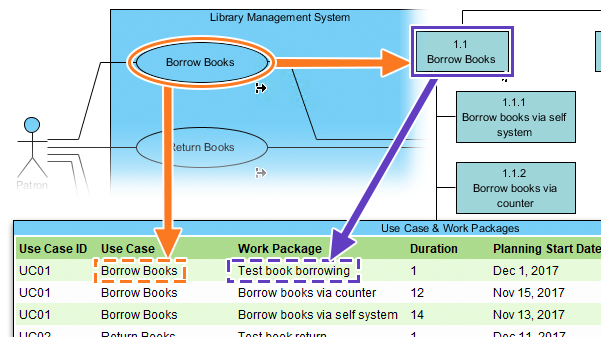
Transformasi: Daftar Terpadu untuk Manipulasi Blok
Fungsi transformasi memfasilitasi pengeditan dan/atau konversi data yang diperoleh ke dalam keadaan yang diinginkan. Dengan Tabel ETL, Anda dapat melakukan pengeditan massal pada beberapa artefak pemodelan dengan cepat dan akurat. Contoh penggunaan: Ekstrak kasus penggunaan dari diagram untuk membentuk Tabel ETL, tinjau kasus penggunaan, tentukan pentingnya dengan klien dan sesuaikan prioritas mereka dalam satu langkah!
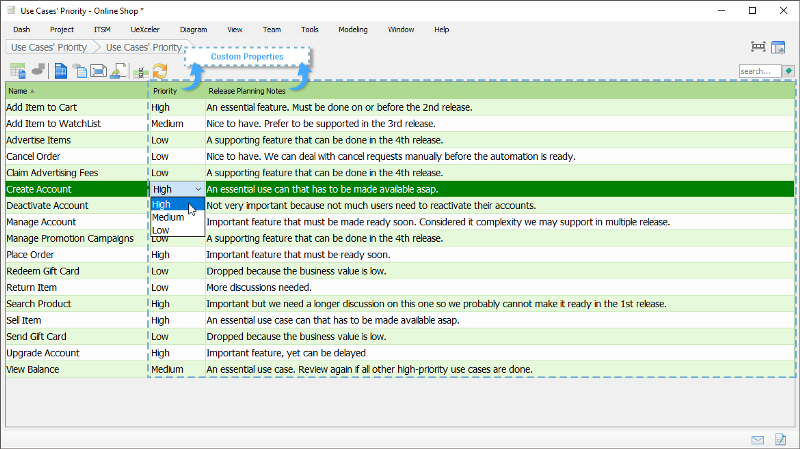
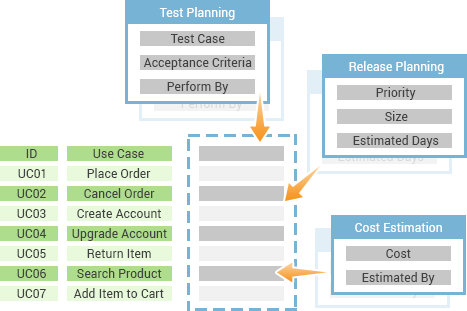
Properti Berorientasi Aspek
Properti Berorientasi Aspek (AOP) adalah sekumpulan nilai bertag yang ditentukan pengguna untuk tujuan yang dapat digunakan kembali. Ini dapat dilampirkan dan dilepas sesuai permintaan untuk perpanjangan model, yaitu, AOP estimasi biaya berlaku untuk baik kasus penggunaan atau cerita pengguna dan sering kali dapat digunakan dalam kombinasi dalam tabel ETL.
Muat: Visualisasikan Model dalam Bentuk Lain
Fungsi muat menulis data yang dihasilkan ke format target seperti, tabel, grafik atau format visual lainnya. Misalnya, bentuk diagram terpisah untuk kasus penggunaan dengan Tinggi prioritas, seperti yang ditunjukkan dalam tabel.
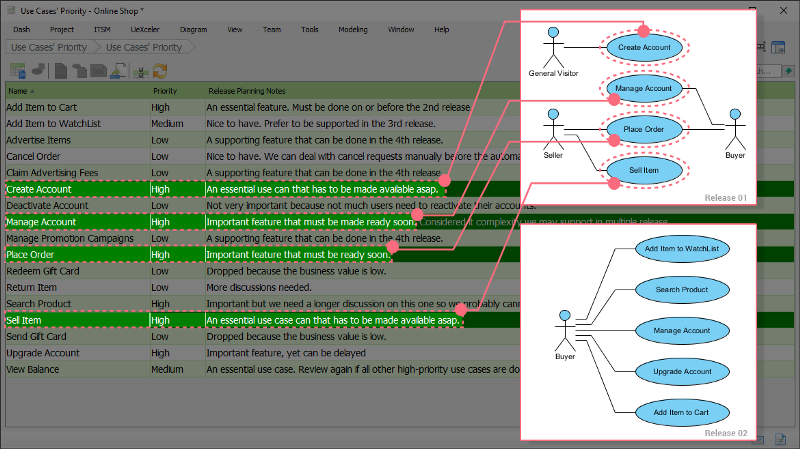
Tabel ETL yang Dapat Dicetak untuk Tujuan Anotasi
Tabel ETL menyediakan sarana yang kuat untuk tujuan anotasi. Tidak hanya memungkinkan untuk melihat dan mengedit model langsung di panel diagram, tetapi juga dapat digunakan sebagai legenda tabel yang dapat diubah ukuran dan dipindahkan. Anda bahkan dapat membuat beberapa Tabel ETL yang berhubungan dengan berbagai jenis model dan kriteria. Kombinasi model (atau diagram) dengan tabel yang dianotasi berdampingan di satu tempat memberikan representasi yang lebih tepat dan informatif bagi pembaca.
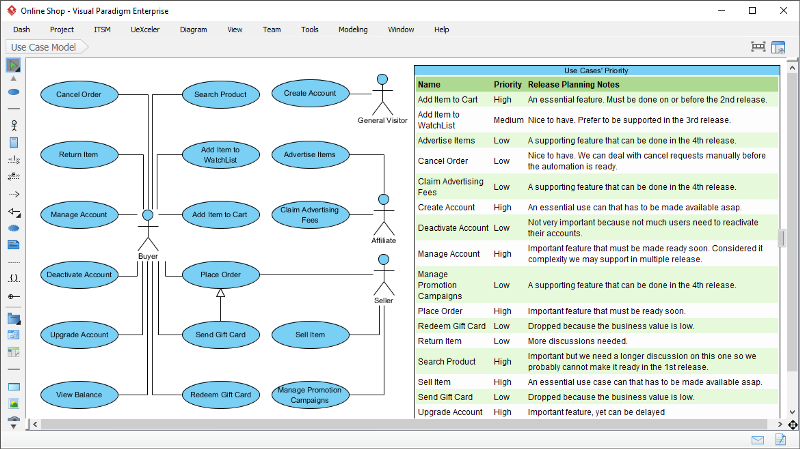
This post is also available in Deutsch, English, Español, فارسی, Français, 日本語, Polski, Portuguese, Ру́сский, Việt Nam, 简体中文 and 繁體中文.













